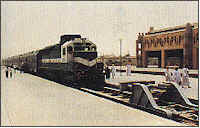|
|
Roads and Railroads
 |
There is a modern rail service between Riyadh and Dammam. |
Beginning with the First Development Plan (1970-74), the country established its comprehensive road network in less than two decades, at a cost of more than 34 billion dollars. Today, the Kingdom is served by 24,448 miles of primary road and 53,317 miles of secondary roads, which facilitate civilian travel as well as commerce throughout the country. An example is the six-lane expressway which links the productive agricultural region of Al-Qasim with Riyadh and the rest of the country. This road, which has 47 bridges, took four years to build. Overall, the highway system is a monument to modern road-building techniques. Particularly spectacular are the highways, with impressively engineered tunnels and bridges, through the arduous mountain terrain of the Asir region in the southern part of the country. One road in the hilly Abha region has the first highway tunnel in the world to be illuminated with solar photovoltaic technology.
The King Fahd Causeway is a showpiece of the Arabian Gulf. It is the second longest in the world, 15 5 miles long, and has connected Saudi Arabia to the state of Bahrain since 1986. This engineering masterpiece, spanning long stretches of sea and reclaimed land, cost 12 billion dollars to build. Its five bridges rest on 536 concrete pylons, with seven embankments constructed in the Gulf's shallower waters. One embankment is actually a sizable artificial island complete with customs and immigration facilities, a mosque and a restaurant. The causeway has not only streamlined the transport of goods and people, but also strengthened the cultural and social bonds between the two nations.
With the highway system now largely in place the government's emphasis has shifted from construction to more efficient operation and maintenance. However, one road project under consideration is a causeway to link Saudi Arabia and Egypt. The 9.24 mile causeway between the Saudi coast and the Sinai peninsula, along Tiran Island, would connect the eastern and western flanks of the Arab world.
In the 1940s, King Abdul Aziz encouraged the building of a railroad from Riyadh through the desert to the port of Dammam. Operated by the Saudi Government Railway Organization (SRO), the line was finished in 1951. In 1992, the railways carried some 414,000 passengers and 1.8 million tons of goods, using 47 locomotives, 58 passenger cars and 2,165 freight cars. One of SRO's major tasks is to transport cargo from Dammam, a modern port on the Arabian Gulf, to Riyadh.
The Riyadh-Dammam line, which has station stops at Hofuf and Abqaiq, is now being extended to the Jubail Industrial City, the site of major industrial facilities. Eventually, the railway network will reach Makkah, Jeddah and Madinah .
|